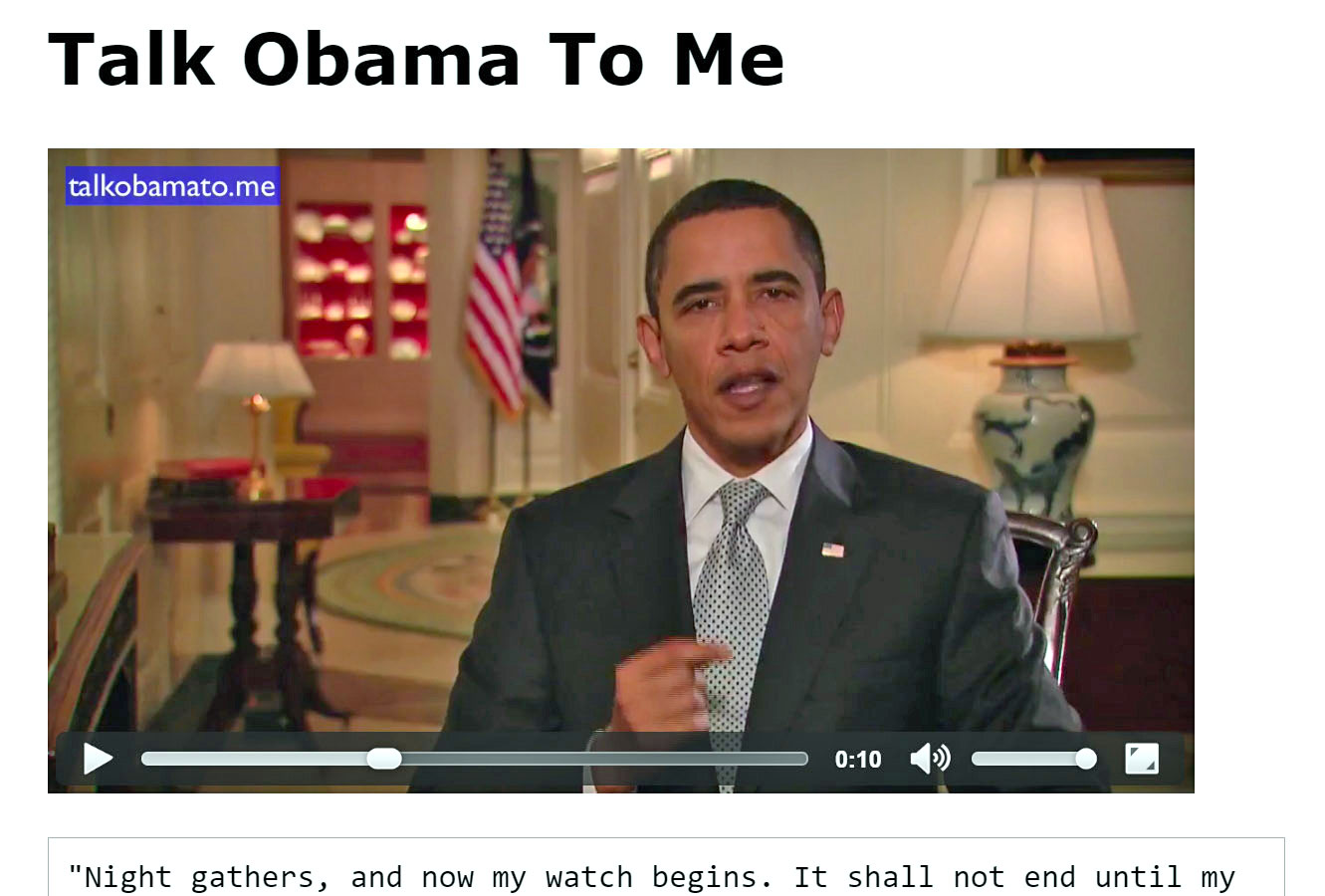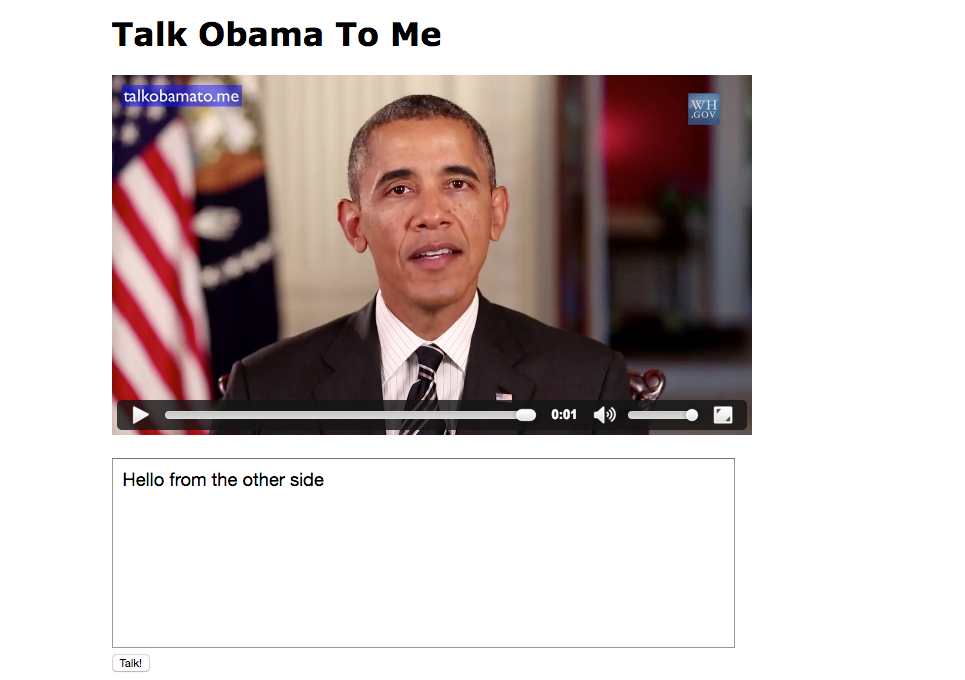Obama Says What You Type! Try This Fun Website
Ever wished you could have Barack Obama deliver a personalized message, perhaps even reciting your favorite song lyrics or, just maybe, dropping a few well-chosen expletives? The digital age has brought this fantastical notion to life, offering the ability to manipulate the former presidents voice and image in ways previously unimaginable.
The evolution of technology has made it possible to create digital replicas of voices, and Barack Obama, with his distinctive cadence and recognizable tone, has become a popular subject for these innovative, albeit potentially controversial, applications. One such platform, "Talk Obama to Me," stands as a prime example of this trend, offering users an interactive experience that blends amusement with the complexities of artificial intelligence and linguistic analysis.
The genesis of "Talk Obama to Me" can be traced back to the creative endeavors of Ed King, a Stanford University linguistics graduate student. King's vision was to develop a tool that would allow users to generate videos of Obama speaking custom text. This project, rooted in the principles of speech synthesis and clip splicing, offers a fascinating insight into how technology is reshaping our relationship with media and public figures.
The website's appeal is undeniable. The premise is straightforward: type in any phrase, and the system stitches together snippets of Obamas recorded speeches, creating a video of him apparently delivering the typed message. Whether its a heartfelt declaration or a humorous quip, the website aims to bring users imaginative creations to life using the former president's voice.
The technical underpinnings of "Talk Obama to Me" are equally intriguing. The platform operates by referencing a comprehensive database of Obama's speeches, meticulously indexed and annotated. When a user inputs a phrase, the software searches for matching word or phrase clips. In cases where direct matches are unavailable, the system employs a more intricate approach: breaking down words into syllables and assembling the audio from these segments. While this method ensures the broadest possible range of phrases, the resulting output might not always be perfectly seamless.
It is important to acknowledge the ethical implications of such technology. While "Talk Obama to Me" primarily serves as a source of entertainment, the potential for misuse is considerable. The ease with which the platform can generate realistic-sounding content raises legitimate concerns about the spread of misinformation, the potential for political manipulation, and the erosion of trust in media.
The website has garnered considerable attention, showcasing the growing interest in AI-powered content creation tools. The user-friendly interface makes it accessible to a broad audience, and the novel concept has the potential to attract both casual users and those interested in linguistics and technology.
The simplicity of the interface belies the sophisticated technology behind it. The program searches through a database of short video clips that are annotated with the word or words that Obama says in each clip. This seemingly simple operation is the core of the platform, which has been a popular trend in the current internet sphere. This has allowed users to witness the former president saying the funniest of things, as well as expressing various political views in the form of fun and creative videos.
The emergence of tools like "Talk Obama to Me" prompts a deeper examination of the boundaries of digital content creation. As AI technology advances, the line between reality and simulation blurs, challenging our perception of authenticity and calling for the establishment of clear ethical guidelines.
Moreover, the project serves as a testament to the capabilities of speech synthesis and the evolving ways in which individuals engage with language and technology. The platform encourages users to experiment with language, remixing the voice of a prominent public figure and re-contextualizing his words. This can be a creative outlet for some and a tool for manipulation for others.
Despite the technical sophistication of tools like "Talk Obama to Me," the underlying concept remains relatively simple. The challenge lies in the meticulous creation of a database that contains a sufficient variety of words and phrases. The quality of the output depends largely on the comprehensiveness and accuracy of this database. The website's reliance on the accuracy of its source material, combined with the creative application of linguistic principles, is key to its success.
In this digital realm, where reality can be easily manipulated, it's important to consider the source and context of any content encountered. The website is a testament to technological advancements. While it is a tool that enables users to exercise creative control over public figures' voices, it also underlines the significance of media literacy and critical evaluation.
The tool's potential impact extends beyond mere entertainment, sparking discussions about the relationship between media, public figures, and the potential consequences of rapidly evolving AI-driven technologies. As such technologies become more advanced and widespread, the necessity for critical thinking and an understanding of how digital content is created becomes even more important. The user must engage in a responsible manner, understanding the potential consequences of such actions.
One of the defining characteristics of the website is its ability to evolve. As technology continues to advance, expect additional options, increased accuracy, and even greater potential for interaction with the original subject. This dynamic quality ensures that "Talk Obama to Me" remains a relevant platform, providing new opportunities for creativity and experimentation.
Here's a table with relevant information about Ed King and the "Talk Obama to Me" project:
| Category | Details |
|---|---|
| Name | Ed King |
| Profession/Role | Linguistics PhD Candidate |
| Affiliation | Stanford University |
| Project | "Talk Obama to Me" |
| Project Description | A website and tool that generates videos of Barack Obama speaking any text entered by the user, using speech synthesis and clip splicing technology. |
| Key Technologies Used | Speech synthesis, clip splicing, database management (for Obama's speech clips), Python (likely used for development), AI |
| Website Link | Due to the nature of the platform, providing a direct, live link may be unreliable. However, the project can be found online by searching for "Talk Obama to Me" on various platforms like Github or social media. |
| Notable Features | Customizable text input, automatic video generation using Obama's voice, database of Obama's clips, syllable breakdown for uncommon words, ability to generate both humorous and realistic results. |
| Educational Significance | Illustrates principles of linguistics, speech synthesis, AI, and digital media manipulation. Offers insights into language technology, data management, and how AI systems can transform content creation. |
The website itself has no age restrictions. The lack of such regulations makes the content easily accessible. The main appeal of the site is that it's not merely a technical experiment; it's a portal to creative expression. By offering an interactive platform, the developers have democratized the process of generating synthetic media, which had previously been the preserve of highly specialized professionals.
The platform's functionality does not simply end with replicating the former president's voice. Its capability to produce custom videos opens up a wide array of applications, including but not limited to, educational purposes, and creative endeavors. It can be a fun and accessible tool for learning more about digital media, language, and technology.
The website is a fascinating example of how language and technology can be combined to provide creative and interesting content. The system's use of Obama's actual speeches helps give it a layer of authenticity, which draws people in and increases the appeal. As technology advances, we can expect to see more of these developments, each offering a new way to express ourselves and connect with each other.
The platform is designed to be easy to use. This focus on simplicity can be attributed to the creative and experimental elements, such as the choice of design elements. This simplicity can be seen as an invitation to the user, allowing for a less complicated experience. This feature is very appealing, regardless of whether the user is a seasoned technology professional or a casual enthusiast. It's a testament to the increasing democratization of technology.
One of the key characteristics of this technology is its ability to evolve, meaning that the quality and accessibility of the site are dependent on the skill of the developer. The design must be adaptable. This evolution helps ensure the site continues to be both functional and relevant. As technology advances, the site will be subject to further improvements in both design and accuracy. The potential for the site to evolve is a central part of its ongoing appeal.
The creation of synthetic content also underscores the importance of digital literacy. It is vital to possess critical thinking skills and an understanding of the ways content is created and manipulated. Users should be able to identify and evaluate the source material and discern the difference between authentic content and AI-generated content.
In conclusion, "Talk Obama to Me" and similar platforms represent a fascinating intersection of linguistics, technology, and popular culture. These websites provide a glimpse into the future of content generation and the significant impact of technology on our perception of authenticity and reality. The website is a reminder of the importance of media literacy in the digital age. It is a call to critical thinking in a world of rapidly evolving technologies. It is a sign that the possibilities are limitless as we enter an era of constant innovation.


